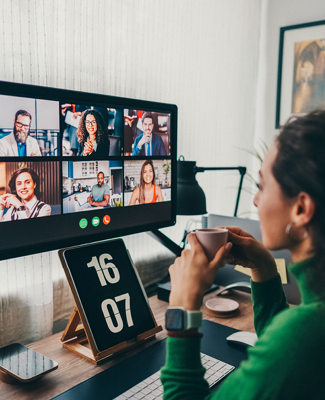Protecting and building a great culture in a remote world
The pandemic has accelerated the trend towards “remote” or “hybrid” work arrangements for both small and large employers, and this has prompted a new concern for organizational leaders: how do I build a company culture when my employees are no longer together?
Every organization, big or small, has a culture – a way of behaving, of making decisions, of experiencing work, of setting expectations. Cultures are created both deliberately and by “osmosis” – the cumulative impact of how the organization operates day-to-day.
Organizations with positive cultures create teams that feel more motivated, stay engaged, and have higher employee morale. Strong cultures also help attract new talent, reduce turnover and absenteeism, and enhance an organization’s brand and perception.
This is all good for performance – towards realizing your mission, hitting your strategic goals, or increasing your bottom line.
 Building a strong, positive and authentic company culture is more challenging in a virtual world.
Building a strong, positive and authentic company culture is more challenging in a virtual world.
Employers may move towards remote or hybrid work arrangements for a number of reasons: health and safety concerns, public health orders, employee or employment market expectations, or a general sense that technology allows for more flexible work practices and introduces new opportunities for efficiency, growth and innovation.
Both employers and employees can see the “upside” in remote or hybrid work. The result is that what was once thought of as temporary now appears to be permanent.
But the impact of remote or hybrid work arrangements on organizational culture can seem uncertain, or even negative.
A culture that came together naturally with regular in-person celebrations and interactions must now be reimagined. Leadership practices and management techniques are confronted with new, complex dynamics. Human resources standards and policies must be modified or even rebuilt.
And, when working through a screen, employees can become socially isolated, have difficulty collaborating, and can miss social cues. Employees may appear engaged, however it may be a different story when the cameras are turned off.
Smaller organizations that relied on close relationships and proximity to create connection can experience a decrease in the daily spontaneous interactions that brought teammates satisfaction and made the organization feel “special”. Larger organizations that invested in communications programs or meeting routines to drive cultural messaging are confronted with new scheduling, technology and management tools and expectations, and decreasing loyalty as employees experience work differently.
Leaders who don’t appreciate the changes that remote or hybrid work can have on their cultures may be putting their positive cultures at risk, or creating a new, unwelcome culture. What should leaders do?
Start with values
It’s unlikely that the pandemic changed what you believed in as an organization – and that should be made clear to everyone. Acceptable behaviour in a workplace remains acceptable virtually – and the opposite is true as well.
Keep your values in mind, and in sight – both in your own behaviour and in communications with your employees. While operational adjustments may be necessary for remote or hybrid employees, remind your employees and their managers that what made you successful and appealing before the introduction of new work arrangements are still important.
Acknowledging that things are different, while also acknowledging that some things shouldn’t be different, is key.
Deliberately find ways to build trust
Without daily in-person interactions remote or hybrid work may loosen the natural bonds that form between colleagues, and between employees and their managers. Remote interactions can feel “contrived”. Worse, the natural social interaction that occurs in-person – which are essential for getting a sense of who each colleague really is – can be missing.
Find ways to interact casually with your colleagues. Instant messaging tools can help, but on-camera interactions are better (and an occasional in-person interaction is best of all). Busy leaders may need to schedule these – but as they’re taking place, keep them light and casual.
Recognize that relationships between managers and employees can shift in subtle and not-always-welcome ways, as managers focus on output instead of people. Be honest about this shift – and work with employees to manage it. Ask career-minded employees if they’re aware of the impact remote or hybrid work may have their own career goals, and create plans to mitigate negative impacts.
Use technology to bridge the teamwork gaps
 One in five employees say communication and collaboration are their biggest pain points when working remotely – which in turn can create misalignment, misunderstanding and sub-cultures that may be at odds with organizational cultural goals.
One in five employees say communication and collaboration are their biggest pain points when working remotely – which in turn can create misalignment, misunderstanding and sub-cultures that may be at odds with organizational cultural goals.
Technology tools can help here – messaging software like Slack or Teams, video software and systems like Zoom and web cameras, and even virtual phones.
Model and encourage their use. These tools give employees opportunities to interact and build connections regularly through team meetings, one on one discussions and even online brainstorming.
Even more, you can incorporate technology tools into your corporate culture. Establishing new expectations and routines around technology-driven interactions can transform an old, positive culture into a new, positive culture. And, of course, having a sense of humour about the quirks and limitations of technology can combat negativity or a sense of isolation.
Together, but apart
Planning remote activities is a great way to keep those working from home happy and engaged. Hosting virtual lunches, coffee breaks, or even watching a movie as a team through Zoom can build better connections with employees. At GroupHEALTH for example, our teams host monthly virtual games (bingo, Pictionary, trivia, etc.) to encourage face time and to have some fun.
If your organizational culture is interaction-driven, consider planning in-person events and gatherings from time-to-time. For smaller organizations these touchpoints may be like a homecoming for many employees, a reminder of the close ties that created a sense of purpose in the first place. In larger organizations, these may be critical for increasing collaboration and creativity, and for creating a connection with an otherwise virtual employer. Done well, these occasional in person events can themselves become a cultural cornerstone, an opportunity for strategic acceleration or team building.
More reading



